The oranges are the very small ones with purple-to-red skin.
The lemons are the large ones with orange skin.
The limes are the medium sized ones with bright yellow skin.
It all makes perfect sense to fans of Moro blood oranges, Meyer lemons, and Bearss limes. And they all taste delicious.
Thursday, March 25, 2010
Tuesday, March 23, 2010
Hike On! Stewart Udall's Legacy, from Sea to Shining Sea
 Stewart Udall, Secretary of the Interior under Presidents Johnson and Kennedy, passed away at the age of 90 on Saturday. Rather than repeat the biographic details found in obituaries, this post pays photographic tribute to his life's passion, our wild public lands.
Stewart Udall, Secretary of the Interior under Presidents Johnson and Kennedy, passed away at the age of 90 on Saturday. Rather than repeat the biographic details found in obituaries, this post pays photographic tribute to his life's passion, our wild public lands. Although a quintessential Westerner who began public life as an Arizona member of Congress, one of his first successes in Washington in 1960 was in New Jersey. He championed citizens who wanted to replace Newark Airport with a larger one, and the creation of the Great Swamp National Wildlife Refuge was the result.
Although a quintessential Westerner who began public life as an Arizona member of Congress, one of his first successes in Washington in 1960 was in New Jersey. He championed citizens who wanted to replace Newark Airport with a larger one, and the creation of the Great Swamp National Wildlife Refuge was the result. As Secretary of the Interior, Udall is credited with helping to pass the Wilderness Act in 1964. Legalese can make for dry, dusty reading, but the Wilderness Act's definition verges on poetry:
A wilderness, in contrast with those areas where man and his own works dominate the landscape, is hereby recognized as an area where the earth and community of life are untrammeled by man, where man himself is a visitor who does not remain.

During the Kennedy and Johnson administrations, public lands expanded immensely, with more than 60 additions to the park system totalling 3.85 million acres, thanks to Stewart Udall. He oversaw the creation of remote Guadalupe Mountains National Park, the highest point in Texas, featuring stark contrasts between mountain and desert and the world's finest example of a fossilized reef.
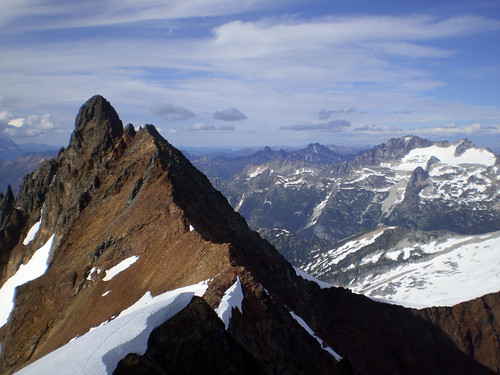 North Cascades National Park, with its high cold peaks and glowing turquoise lakes, is part of his legacy. So are the misty, mystical Redwoods National Park in California, home of the world's tallest trees (below). He also deserves credit for expanding types of units (beyond national parks and monuments), such as the National Trails System (including the Appalachian Trail) established in 1968; the country's national seashores, including Point Reyes, Cape Hatteras, Padre Island, and Cape Cod National Seashores; and national recreation areas such as the Santa Monica Mountains National Recreation Area in Los Angeles (which keeps me sane). The Land and Water Conservation Act of 1965, which funds parks as big as the Grand Canyon and as small as your kid's soccer field from federal oil lease money, shows legislative ingenuity.
North Cascades National Park, with its high cold peaks and glowing turquoise lakes, is part of his legacy. So are the misty, mystical Redwoods National Park in California, home of the world's tallest trees (below). He also deserves credit for expanding types of units (beyond national parks and monuments), such as the National Trails System (including the Appalachian Trail) established in 1968; the country's national seashores, including Point Reyes, Cape Hatteras, Padre Island, and Cape Cod National Seashores; and national recreation areas such as the Santa Monica Mountains National Recreation Area in Los Angeles (which keeps me sane). The Land and Water Conservation Act of 1965, which funds parks as big as the Grand Canyon and as small as your kid's soccer field from federal oil lease money, shows legislative ingenuity. The vast, gorgeous, rugged labyrinth of Canyonlands National Park was established with his help.

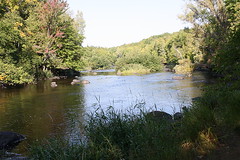 The next time you take a whitewater rafting trip on the Rogue River in Oregon, salute Stewart Udall. If you'd prefer to fish for sturgeon on the Wolf River in Wisconsin (shown) or float the Verde River in Arizona or the Merced River in Yosemite Valley, thank him too for his role in passing the Wild and Scenic Rivers Act.
The next time you take a whitewater rafting trip on the Rogue River in Oregon, salute Stewart Udall. If you'd prefer to fish for sturgeon on the Wolf River in Wisconsin (shown) or float the Verde River in Arizona or the Merced River in Yosemite Valley, thank him too for his role in passing the Wild and Scenic Rivers Act. 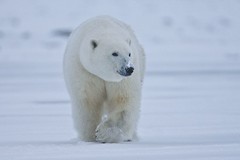 Not content with reshaping the great wild lands of the United States, he also helped to save Carnegie Hall from destruction.
Not content with reshaping the great wild lands of the United States, he also helped to save Carnegie Hall from destruction. He played a role in the National Wildlife Refuge System Administration Act of 1966, arguably the most significant refuge law since the Migratory Bird Act of 1929 first codified refuge administration. Without that law, there would be no Arctic National Wildlife Refuge, no Key West National Wildlife Refuge, nor 56 refuges between, all established during his tenure.
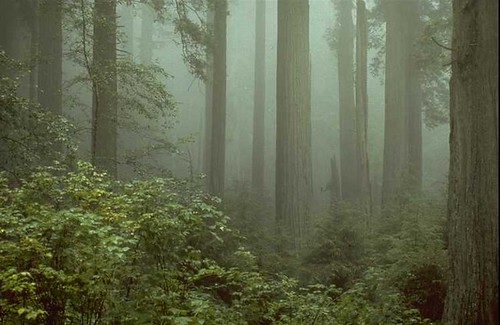
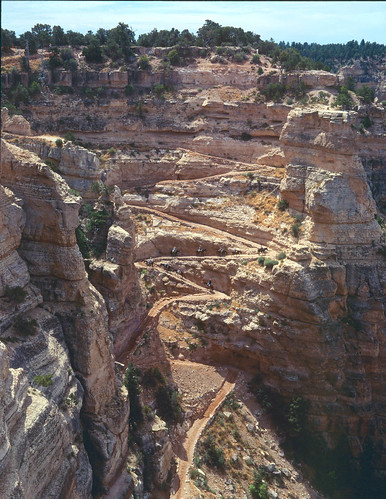
President Obama's statement:
For the better part of three decades, Stewart Udall served this nation honorably. Whether in the skies above Italy in World War II, in Congress or as Secretary of the Interior, Stewart Udall left an indelible mark on this nation and inspired countless Americans who will continue his fight for clean air, clean water and to maintain our many natural treasures. Michelle and I extend our condolences to the entire Udall family who continue his legacy of public service to this day.
In honor of work by him and his brother Morris Udall, both patriots who loved their country from sea to shining sea, the easternmost and westernmost points in the country bear their names.
Two details stand out from the New York Times obituary on a life well lived, priorities in order, optimistic, resilient and relevant to the end. From his last Grand Canyon whitewater trip, he hiked from the river to the canyon rim, refusing a mule, 10 strenuous miles uphill, to enjoy a well-deserved martini. At the age of 84. And a recent letter to his grandchildren urged them to focus on "trying to transform our society to a clean energy and clean job society."
Monday, March 22, 2010
A tiny bit of good news
Late last week, I heard that Senator John McCain (R-AZ) would propose, as early as today, an amendment to an unrelated bill that could increase the number of helicopter flights over the Grand Canyon and deprive the public of input into the noise management plan being developed by the National Park Service. I put together a quick DailyKos/FDL diary, John McCain's temper vs. Grand-Canyon: quick action alert!, asked others to call their Senators, and sent the diary to a few people, notably Senator Jeff Bingaman (D-NM). I also called and emailed my one Senator who might consider voting for this amendment, to be told that she was still reviewing. Later on today, I learned that Senator Bingaman gave a great speech, McCain withdrew the amendment, the unrelated bill passed 93-0, and all's well with the Grand Canyon (until the EIS will be released, in which case the noise battle can be fought all over again).
Did I influence the outcome? Almost certainly not. Bingaman didn't like the amendment before getting any emails from me. My Senators never voted on the amendment. Alerts from the Sierra Club and National Parks Conservation Association and on other blogs probably generated far more phone calls than my one humble effort. Still, it feels good to be a tiny part of the larger effort.
Did I influence the outcome? Almost certainly not. Bingaman didn't like the amendment before getting any emails from me. My Senators never voted on the amendment. Alerts from the Sierra Club and National Parks Conservation Association and on other blogs probably generated far more phone calls than my one humble effort. Still, it feels good to be a tiny part of the larger effort.
Sunday, March 21, 2010
Climate Change: On the Beach, or Going to Holland?
Climate news ranges from serious to depressing to "It's 'Game Over' For Humanity As We Know It." People pose the question: "shouldn't we just party on with the time we have left?"
In Nevil Shute's post-atomic-war On the Beach, Australian survivors of World War III wait for a cloud of radiation fallout to arrive. While waiting for certain doom, some of them attempt to lead normal lives, planting gardens that they will never see. Others in similar scenarios might turn to religion and mysticism; denial; hedonism; or contemplation of fate, possibly through the arts. Others may simply give up and surrender to despair.
Climate change does not mean certain doom for humanity. Our world will change, and we must accept its changes, but the changes do not automatically mean the end of the world. Compare being on the beach with going to Holland. This short, beautiful parable was written by the parent of a child born with a disability, analogizing it to a dream vacation in Italy. Instead of going to Italy, you learn you're going to Holland. You're angry and disappointed...until you see that Holland has tulips and windmills. It's not worse than Italy. It's just different. For the rest of your life, you will face the loss of that dream:
It's not worse than Italy. It's just different. For the rest of your life, you will face the loss of that dream:
Two recent reports illustrate the stark difference between choosing to live on the beach of business as usual and going to Holland.
The United Nations Environmental Programme Compendium 2009 could be summed up as Climate worse than we thought. A lot worse. Even if we enact an economy-wide cap on carbon and other countries stick with their plans to reduce carbon, we are still likely to see global temperatures rise between 1.4 and 4.3 degrees Celsius by 2100, with an equilibrium of 2.4 degrees Celsius, which will likely trigger three tipping points. The mainstream media reported that temperatures will rise 6.3 degrees Fahrenheit (but, oddly, missed the tipping point of the UNEP report).
Separately, a British conference tackled the consequences of life at 4 degrees Celsius at 2060. Computer modeling shows wildly uneven impacts all over the globe.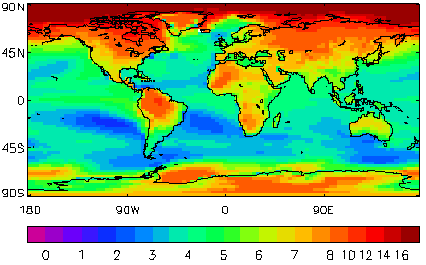 Large parts of the inland United States would warm 10 to 12 degrees C. An average of four degrees C masks the worst increases; for example, southern and western Africa and the Arctic could each see rises of 10 degrees C. Water supplies for half the world's population would be threatened, and up to half the world's animal and plant species would die. This "plausible worst case scenario" arises from business as usual in which carbon emissions are not sharply curtailed.
Large parts of the inland United States would warm 10 to 12 degrees C. An average of four degrees C masks the worst increases; for example, southern and western Africa and the Arctic could each see rises of 10 degrees C. Water supplies for half the world's population would be threatened, and up to half the world's animal and plant species would die. This "plausible worst case scenario" arises from business as usual in which carbon emissions are not sharply curtailed.
Nevertheless, hope lives.
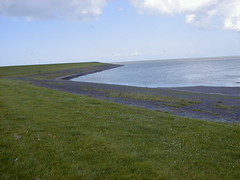 In a business as usual scenario, the usual businesses continue to prosper until we all end up on the beach: game over, watching football, drinking, praying, despairing, or carrying on as if nothing has changed. We can, instead, choose to go to Holland. In Holland, we acknowledge the changes we have wrought in the world while mourning the loss of our old way of life. In Holland, there are no polar bears, and humans will be displaced by rising seas. However, Holland has tulips, and windmills, and -- most important -- polders, low lying tracts of land enclosed entirely by dikes. The ever-present threat of sea level rise has led not only to engineering marvels, but also the political marvel of the polder model, emphasizing cooperation despite differences in the face of a common natural enemy.
In a business as usual scenario, the usual businesses continue to prosper until we all end up on the beach: game over, watching football, drinking, praying, despairing, or carrying on as if nothing has changed. We can, instead, choose to go to Holland. In Holland, we acknowledge the changes we have wrought in the world while mourning the loss of our old way of life. In Holland, there are no polar bears, and humans will be displaced by rising seas. However, Holland has tulips, and windmills, and -- most important -- polders, low lying tracts of land enclosed entirely by dikes. The ever-present threat of sea level rise has led not only to engineering marvels, but also the political marvel of the polder model, emphasizing cooperation despite differences in the face of a common natural enemy.
The choice is stark.
In Nevil Shute's post-atomic-war On the Beach, Australian survivors of World War III wait for a cloud of radiation fallout to arrive. While waiting for certain doom, some of them attempt to lead normal lives, planting gardens that they will never see. Others in similar scenarios might turn to religion and mysticism; denial; hedonism; or contemplation of fate, possibly through the arts. Others may simply give up and surrender to despair.
Climate change does not mean certain doom for humanity. Our world will change, and we must accept its changes, but the changes do not automatically mean the end of the world. Compare being on the beach with going to Holland. This short, beautiful parable was written by the parent of a child born with a disability, analogizing it to a dream vacation in Italy. Instead of going to Italy, you learn you're going to Holland. You're angry and disappointed...until you see that Holland has tulips and windmills.
 It's not worse than Italy. It's just different. For the rest of your life, you will face the loss of that dream:
It's not worse than Italy. It's just different. For the rest of your life, you will face the loss of that dream: And the pain of that will never, ever, ever, ever go away... because the loss of that dream is a very very significant loss.
But... if you spend your life mourning the fact that you didn't get to Italy, you may never be free to enjoy the very special, the very lovely things ... about Holland.
Two recent reports illustrate the stark difference between choosing to live on the beach of business as usual and going to Holland.
The United Nations Environmental Programme Compendium 2009 could be summed up as Climate worse than we thought. A lot worse. Even if we enact an economy-wide cap on carbon and other countries stick with their plans to reduce carbon, we are still likely to see global temperatures rise between 1.4 and 4.3 degrees Celsius by 2100, with an equilibrium of 2.4 degrees Celsius, which will likely trigger three tipping points. The mainstream media reported that temperatures will rise 6.3 degrees Fahrenheit (but, oddly, missed the tipping point of the UNEP report).
Separately, a British conference tackled the consequences of life at 4 degrees Celsius at 2060. Computer modeling shows wildly uneven impacts all over the globe.
 Large parts of the inland United States would warm 10 to 12 degrees C. An average of four degrees C masks the worst increases; for example, southern and western Africa and the Arctic could each see rises of 10 degrees C. Water supplies for half the world's population would be threatened, and up to half the world's animal and plant species would die. This "plausible worst case scenario" arises from business as usual in which carbon emissions are not sharply curtailed.
Large parts of the inland United States would warm 10 to 12 degrees C. An average of four degrees C masks the worst increases; for example, southern and western Africa and the Arctic could each see rises of 10 degrees C. Water supplies for half the world's population would be threatened, and up to half the world's animal and plant species would die. This "plausible worst case scenario" arises from business as usual in which carbon emissions are not sharply curtailed.Nevertheless, hope lives.
Betts said: "It's important to stress it's not a doomsday scenario, we do have time to stop it happening if we cut greenhouse gas emissions soon." Soaring emissions must peak and start to fall sharply within the next decade to head off a 2C rise, he said. To avoid the 4C scenario, that peak must come by the 2030s.
 In a business as usual scenario, the usual businesses continue to prosper until we all end up on the beach: game over, watching football, drinking, praying, despairing, or carrying on as if nothing has changed. We can, instead, choose to go to Holland. In Holland, we acknowledge the changes we have wrought in the world while mourning the loss of our old way of life. In Holland, there are no polar bears, and humans will be displaced by rising seas. However, Holland has tulips, and windmills, and -- most important -- polders, low lying tracts of land enclosed entirely by dikes. The ever-present threat of sea level rise has led not only to engineering marvels, but also the political marvel of the polder model, emphasizing cooperation despite differences in the face of a common natural enemy.
In a business as usual scenario, the usual businesses continue to prosper until we all end up on the beach: game over, watching football, drinking, praying, despairing, or carrying on as if nothing has changed. We can, instead, choose to go to Holland. In Holland, we acknowledge the changes we have wrought in the world while mourning the loss of our old way of life. In Holland, there are no polar bears, and humans will be displaced by rising seas. However, Holland has tulips, and windmills, and -- most important -- polders, low lying tracts of land enclosed entirely by dikes. The ever-present threat of sea level rise has led not only to engineering marvels, but also the political marvel of the polder model, emphasizing cooperation despite differences in the face of a common natural enemy.The choice is stark.
Climate change: Broken People in America
 "Climate refugees": the term refers to people whose distance dulls the pain of hearing their stories, like Shahana Begum of Bangladesh.
"Climate refugees": the term refers to people whose distance dulls the pain of hearing their stories, like Shahana Begum of Bangladesh. Shahana's family, like more than half a million people in the impoverished nation, lost her shanty home and all her belongings when cyclone Sidr slammed into southern Bangladesh in November 2007, claiming more than 3,500 lives.
"I moved to Dhaka because there was nowhere else to go," said Shahana, for whom home is now a slum on the dry banks of the capital's biggest river.
The country's leading climate change scientist says it is a sign of things to come. "It used to be that we would have a big cyclone every 15 to 20 years. We are getting a big one now every two or three years," said Atiq Rahman, who was on the UN's Inter-government Panel on Climate Change (IPCC). The Nobel Prize-winning IPCC predicts 20 million Bangladeshis will be displaced by 2050 because of sea level rises and an increase of natural disasters caused by changing weather patterns.
This tragedy could never happen in America.
Bangladesh, population 160 million, is among the countries most hard hit by climate change; an estimated 20 million people -- 1 in every 8 -- will need to be relocated by 2050 because of climate. Poverty and geography cause fragility: the country sits within the Ganges River delta, and 50% of the country would disappear if sea levels rise one meter. The news seems to be always bad -- famine, floods, erosion, lather, rinse, repeat. It's easy to become numb to words on a page. So we take pictures to explain what words cannot.
Shishmaref: "We are worth saving!"
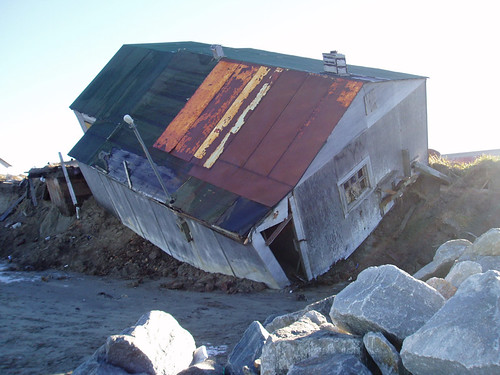
We are worth saving! begged the island village of Shishmaref, before abandoning their homeland altogether.
A villager who has lived most of his life in Shishmaref pleads: "This is our home, this is where we live, where I grew up. Over 100 years we have been at this site as Shishmaref, starting with the school and everything, but it’s been thousands of years since the Shishmaref people have been using this island as a pasture point for the ocean."

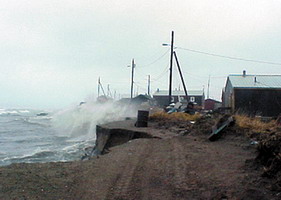 Note the placement of the trash can in the center of the "before" and "after" pictures. Erosion occurs along the entire island chain, but exacerbated at Sarichef Island in part because of the hydrographic impacts of hard armoring of a sandy shoreface and permafrost degradation, accelerated by human infrastructure. The island now plans to relocate to the Alaska mainland. Yes, you read that right: Shishmaref is a part of the United States, not Bangladesh.
Note the placement of the trash can in the center of the "before" and "after" pictures. Erosion occurs along the entire island chain, but exacerbated at Sarichef Island in part because of the hydrographic impacts of hard armoring of a sandy shoreface and permafrost degradation, accelerated by human infrastructure. The island now plans to relocate to the Alaska mainland. Yes, you read that right: Shishmaref is a part of the United States, not Bangladesh.Isle de Jean Charles: Deliberately abandoned by the Army Corps
At the opposite end of America, Louisiana loses land: 30 square miles every year. A long-planned Army Corps of Engineers project, Morganza to the Gulf of Mexico Hurricane Protection Project (also known as the Great Wall of Louisiana), would protect parts of Louisiana from storm surges and climate change. However, it was designed to abandon the Native American people of Isle de Jean Charles. In 2006, a levee district director explained that it was simply a question of money:

"The problem is, based on the cost-benefit ratio, it would cost too much to include that sliver of land. For the cost, you could buy the island and all the residents tenfold."
In effect, the government had to ask itself: is it worth $100 million or more to protect a shrinking spit of an island, its only road, its modest homes, some of them little more than shacks, and its 250 residents, whose families have lived here for generations? Its conclusion: no.
By fall 2009, the same tribe announced plans to abandon its island home, instead using 12 million dollars in federal aid to move 230 people 10 miles inland. The Great Wall of Louisiana may not even work, and there may come a time to abandon places larger than Isle de Jean Charles. The Army Corps of Engineers' chief recently acknowledged as much when asked whether New Orleans should be abandoned entirely? Without answering that question, he told a reporter: "Protect the city, no. Reduce the risk, yes."
Kivalina: Climate cover-up succeeds
This photo shows the impact of sea level rise on Kivalina, Alaska far better than any words can:
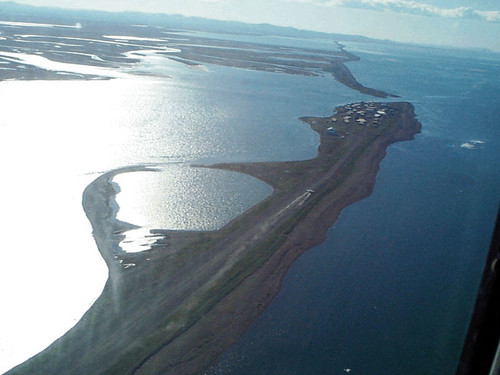
Kivalina's residents decided to fight back. They hired prominent lawyers to sue 24 large polluters. More important, the suit also accused eight of the firms (American Electric Power, BP America, Chevron, ConocoPhillips, Duke Energy, ExxonMobil, Peabody Energy, and Southern Company) of conspiring to cover up the threat of man-made climate change, in much the same way the tobacco industry tried to conceal the risks of smoking (as detailed in Jim Hoggan's recent, thoroughly researched Climate Cover-Up). On October 16, a federal district court judge dismissed (24 pg pdf) Kivalina's complaint (for legalnerds, the ruling was on political question and standing grounds). The plaintiffs plan to appeal to the Ninth Circuit.
Newtok: Broken people
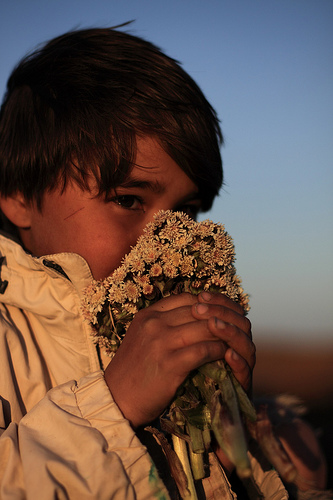 Newtok, Alaska is a village being squeezed between two rising rivers. It's lost an average of 72 feet a year to the water between the 1950s and 2005. Senator Lisa Murkowski (R-AK) compares the villagers to American Indians losing their ancestral homes:
Newtok, Alaska is a village being squeezed between two rising rivers. It's lost an average of 72 feet a year to the water between the 1950s and 2005. Senator Lisa Murkowski (R-AK) compares the villagers to American Indians losing their ancestral homes: "But what we're talking about here is the existence of a people. When they are separated from their land, they lose their language. They lose their culture. They lose their identify. And what do we have for it? Broken people."
"We saw that, to certainly an extent, with the American Indian when we took them away from the land and gave them reservations and said, 'Here, here's how we're going to make it even,' " she said.
America's broken and abandoned people are not limited to these four villages. In Alaska alone, 31 villages are imminently threatened by erosion, with 178 more communities -- including its largest city, Anchorage -- vulnerable to erosion. Even if they're all relocated, they're not legally "climate refugees" because they're not moving from one country to another. Climate refugees have been described as the third rail of climate policy. Under the Geneva Convention, a "refugee" is a person who flees from one country to another, such as the millions who have fled drought between Kenya and Somalia. The United States has no long-term relocation policy for people whose homelands become unlivable due to climate change. Instead, affected villages have been clamoring for federal and state money on an ad hoc basis.
The broken people of villages such as Shishmarek and Isle de Jean Charles have more in common with Shahana Begum and other Bangladesh people than they do with the average middle-class American: native people, practicing a subsistence lifestyle in a fertile land, being harmed by forces far away. To this middle-class American observer, they're the 21st century equivalent of Native Americans being forced off their homelands, through no fault of their own, and herded on to reservations.
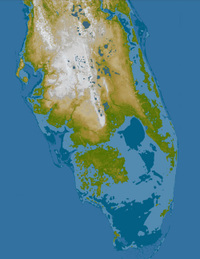 The Senate Environmental & Public Works Committee begins hearings tomorrow on the Kerry-Boxer bill, Most of the debate this week will be on its dollars-and-cents costs and benefits. Will Senators Murkowski and Begich of Alaska, and Landrieu and Vitter of Louisiana, demand justice for their people, or will they vote for their shares of oil contributions? Rising seas will not respect their votes.
The Senate Environmental & Public Works Committee begins hearings tomorrow on the Kerry-Boxer bill, Most of the debate this week will be on its dollars-and-cents costs and benefits. Will Senators Murkowski and Begich of Alaska, and Landrieu and Vitter of Louisiana, demand justice for their people, or will they vote for their shares of oil contributions? Rising seas will not respect their votes. Our treatment of poverty-stricken villages sets a precedent for how we will treat others affected by sea level rise. Will the residents of Dade County, Florida plead "We are worth saving!" or will they simply allow themselves to be meekly herded off their land? Will the Army Corps of Engineers ultimately decide that the costs of storm surge barriers and seawalls around this city are too high?
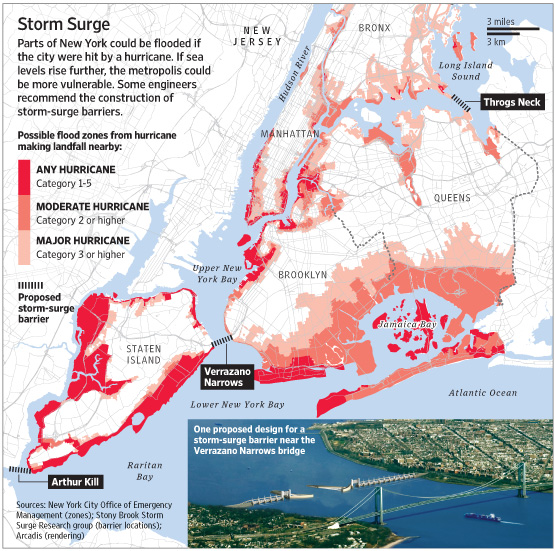
Or will we treat people with money different from people at the margins of American society?
Labels:
Alaska,
climate change,
environmental justice,
Louisiana
Twittering away
I always said I refuse to twit, trying to condense thoughts into arbitrary tiny character limits. I'm not an early adopter of new technologies. It's time.
Follow me: RL_Miller on Twitter.
Follow me: RL_Miller on Twitter.
Monumental Follies: Utah Says No to New Jobs

The guvmint-hatin' Utah state legislature has just declared a preemptive strike against creating new jobs and revenue in the state. Today, the state senate passed a resolution opposing federal creation of new monuments. A few weeks ago, a Department of the Interior memo brainstorming 14 possible national monuments, including two in Utah, was leaked to a national park-hating member of Congress, creating a firestorm of manufactured controversy throughout the West. In response, Republican-dominated state legislatures are railing against an entirely chimerical federal land grab. Consider it a Sagebrush Rebellion 2.0.
Just how bad for Utah would those new national monuments be?
The Utah state senate's resolution, following a similar one in the state house of representatives, is not binding on the federal government. The Antiquities Act of 1906 gives the President the power to declare monuments regardless of the opinion of any state legislature. Instead, the resolution is part of a larger Sagebrush Rebellion 2.0, being cynically manufactured by western Republicans.
Consider what impact the national parks and monuments have on Utah.
* In 2008, the last year studied (53 pg pdf), non-local visitors spent $548,251,000 in Utah. The Park Service employed 971 people, and national park-related businesses employed an additional 11,340 people, in Utah.
* The state's official travel site invites the visitor: "Welcome to Utah, paradise for outdoor enthusiasts! From National Parks to ski resorts..." with a page devoted just to Utah, "America's National Parks capital" and another page extolling the virtues of Utah's national monuments.
* These numbers don't do justice to the pride that Utahns take in their land. The state license plate shows Delicate Arch in Arches National Park (formerly Arches National Monument). Utah has some of the most spectacular scenery in the country, and much of it is conserved as national parks and monuments.
 One of the two proposed national monuments is the San Rafael Swell (pictured), geologically and geographically similar to Capitol Reef National Park. Capitol Reef's non-local visitors spent $27,842,000 in 2008, and the federal government spent an additional $1,141,000 on payroll. If the San Rafael Swell becomes a national monument, similar numbers should be expected. Currently, it's managed by the Bureau of Land Management, has no visitor services, and is used only by off road vehicles and very intrepid hikers.
One of the two proposed national monuments is the San Rafael Swell (pictured), geologically and geographically similar to Capitol Reef National Park. Capitol Reef's non-local visitors spent $27,842,000 in 2008, and the federal government spent an additional $1,141,000 on payroll. If the San Rafael Swell becomes a national monument, similar numbers should be expected. Currently, it's managed by the Bureau of Land Management, has no visitor services, and is used only by off road vehicles and very intrepid hikers.After all, the Utah state legislature can easily afford to say no to jobs and revenue, right? The latest draft of the state budget cuts education by $21 million, adds a cigarette tax, and cuts the Utah State Hospital's budget by $500,000.
But what's mere money when Republicans can stand on principles against a socialist federal guvmint land grab?
Saturday, March 20, 2010
Hike On! Worst Case Scenario, Colorado Hiking Edition
I really wonder about the popularity of those Worst Case Scenario books even as I browse them. They're clearly written for extreme situations. The advice is serious (in a superficial way), not snarky. Yet who plans to be in an extreme life-or-death situation? Who, when finding oneself in an extreme life-or-death situation, would have the presence of mind to pull out and consult a little yellow handbook? And who, having the book handy, would also have whatever tools are deemed necessary to survive the worst case?
We were camping with our boys, then aged three and nearly-one. We planned to drive to a pretty little lake, hike, and drive back to the campground. The lake was very pretty, but the path around it was flat.
In my world, one either strolls or hikes. Hiking involves hills, water, an elevated heart rate, and views; it's a good thing. Strolling involves flat paths, a cup of designer coffee and a cel phone, a sense of leisure, and a mall; it has its place, but that place is not Rocky Mountain National Park. We finish our stroll -- and it was a stroll, not a hike -- around the pretty lake by 11 AM. My then-husband thinks that's quite sufficient for the day, but I want to do more (perhaps that's a reason he became an ex-husband...but I digress). I consult the park handout map, devise a ten mile trail across a couple of ridgetops that would take me back to camp, refill the water bottles, and set out.
I hike alone about three miles straight up. So far, so good. The pretty little lake is just a speck down below. The trail is clearly marked, albeit little used on a beautiful sunny August day. I sing John Denver, badly, just like every other tourist in Colorado. Somewhere above the 10,000 foot mark, I pass the treeline (a point above which trees can't survive, although smaller alpine plants can.) Then the clouds roll in.
I'm a California native, and our storms take days to arrive. I'm not used to the Mountain West pattern of sudden afternoon thundershowers, and I'm only wearing typical summer t-shirt-and-shorts attire. Pretty soon, I'm drenched, but I continue on. A couple of bluejays squawk at me, as if to say "Foolish human!" I ignore them.
Thunder booms, not terribly far away. There's a couple of lightning strikes. I can tell, by the split seconds between the flashes and the noise, that the lightning is very, very close. I remember, quite fondly, a night spent in a wilderness above Pendleton, OR during a dry lightning storm, during which you could read a book by the near-constant glare. I keep hiking. I'm now the tallest thing on an exposed ridgeline.
Suddenly my entire field of vision goes blinding-white just as noise fills my ears. A bizarre sensation, like an electric shock, but much, much larger, and excruciatingly painful, smites me -- yes, "smites" is the right word. I'm knocked to the ground. I'm knocked out. When I come to, I'm sick to my stomach. At first I can't move my limbs at all. I stagger up like a drunken sailor, but still can't move my facial muscles. A couple of hours later the feeling dials down to tongue-swollen-and-numb.
I've been ground-shocked by lightning! I haven't suffered a direct hit. However, the lightning charge has traveled through the wet ground and up through me. If I had to estimate, the bolt came down perhaps ten feet away. A bolt of lightning can be 28,000 degrees fahrenheit, or five times hotter than the surface of the sun. I consider my options. I'm nearly halfway done with the hike, but if I were to return to the pretty lake, my husband would be gone and I'd be twenty road miles back to camp. I decide to finish the remaining six miles of the hike.
Much thereafter is blurry. A marmot scampers across the trail. It's laughing at me. Somehow I stagger back to camp. My husband decides we should go to the ranger station and ask about first aid. At the ranger station, I tell my story, whereupon I'm advised: If you're not dead already, you'll be fine.
And that, dear reader, is your Worst Case Scenario tip of the day on how to survive being struck by lightning: Don't die! No handbook required. If you do consult the Worst Case Scenarios handbook or webpage, you'll learn how to avoid lightning (stay below the treeline, get flat, and get inside), and you'll learn how to give CPR to someone who's been struck by lightning, but you won't learn how to get struck by lightning and live. (For the detail-oriented, Wikipedia elaborates: "The most critical injuries are to the circulatory system, the lungs, and the central nervous system. Many victims suffer immediate cardiac arrest and will not survive without prompt emergency care, which is safe to administer because the victim will not retain any electrical charge after the lightning has struck. Others incur myocardial infarction and various cardiac arrhythmias, either of which can be rapidly fatal as well. Loss of consciousness is very common immediately after a strike. Amnesia and confusion of varying duration often result as well." Thanks. I wouldn't have known that without reading it here.)
On the way back to California, we spend one night at a Vegas hotel. The afternoon thundershowers roll in. The lifeguards order everyone out of the pool. I'm the first one out. From here on, I take lightning seriously. However, I keep hiking.
We were camping with our boys, then aged three and nearly-one. We planned to drive to a pretty little lake, hike, and drive back to the campground. The lake was very pretty, but the path around it was flat.
In my world, one either strolls or hikes. Hiking involves hills, water, an elevated heart rate, and views; it's a good thing. Strolling involves flat paths, a cup of designer coffee and a cel phone, a sense of leisure, and a mall; it has its place, but that place is not Rocky Mountain National Park. We finish our stroll -- and it was a stroll, not a hike -- around the pretty lake by 11 AM. My then-husband thinks that's quite sufficient for the day, but I want to do more (perhaps that's a reason he became an ex-husband...but I digress). I consult the park handout map, devise a ten mile trail across a couple of ridgetops that would take me back to camp, refill the water bottles, and set out.
I hike alone about three miles straight up. So far, so good. The pretty little lake is just a speck down below. The trail is clearly marked, albeit little used on a beautiful sunny August day. I sing John Denver, badly, just like every other tourist in Colorado. Somewhere above the 10,000 foot mark, I pass the treeline (a point above which trees can't survive, although smaller alpine plants can.) Then the clouds roll in.
I'm a California native, and our storms take days to arrive. I'm not used to the Mountain West pattern of sudden afternoon thundershowers, and I'm only wearing typical summer t-shirt-and-shorts attire. Pretty soon, I'm drenched, but I continue on. A couple of bluejays squawk at me, as if to say "Foolish human!" I ignore them.
Thunder booms, not terribly far away. There's a couple of lightning strikes. I can tell, by the split seconds between the flashes and the noise, that the lightning is very, very close. I remember, quite fondly, a night spent in a wilderness above Pendleton, OR during a dry lightning storm, during which you could read a book by the near-constant glare. I keep hiking. I'm now the tallest thing on an exposed ridgeline.
Suddenly my entire field of vision goes blinding-white just as noise fills my ears. A bizarre sensation, like an electric shock, but much, much larger, and excruciatingly painful, smites me -- yes, "smites" is the right word. I'm knocked to the ground. I'm knocked out. When I come to, I'm sick to my stomach. At first I can't move my limbs at all. I stagger up like a drunken sailor, but still can't move my facial muscles. A couple of hours later the feeling dials down to tongue-swollen-and-numb.
I've been ground-shocked by lightning! I haven't suffered a direct hit. However, the lightning charge has traveled through the wet ground and up through me. If I had to estimate, the bolt came down perhaps ten feet away. A bolt of lightning can be 28,000 degrees fahrenheit, or five times hotter than the surface of the sun. I consider my options. I'm nearly halfway done with the hike, but if I were to return to the pretty lake, my husband would be gone and I'd be twenty road miles back to camp. I decide to finish the remaining six miles of the hike.
Much thereafter is blurry. A marmot scampers across the trail. It's laughing at me. Somehow I stagger back to camp. My husband decides we should go to the ranger station and ask about first aid. At the ranger station, I tell my story, whereupon I'm advised: If you're not dead already, you'll be fine.
And that, dear reader, is your Worst Case Scenario tip of the day on how to survive being struck by lightning: Don't die! No handbook required. If you do consult the Worst Case Scenarios handbook or webpage, you'll learn how to avoid lightning (stay below the treeline, get flat, and get inside), and you'll learn how to give CPR to someone who's been struck by lightning, but you won't learn how to get struck by lightning and live. (For the detail-oriented, Wikipedia elaborates: "The most critical injuries are to the circulatory system, the lungs, and the central nervous system. Many victims suffer immediate cardiac arrest and will not survive without prompt emergency care, which is safe to administer because the victim will not retain any electrical charge after the lightning has struck. Others incur myocardial infarction and various cardiac arrhythmias, either of which can be rapidly fatal as well. Loss of consciousness is very common immediately after a strike. Amnesia and confusion of varying duration often result as well." Thanks. I wouldn't have known that without reading it here.)
On the way back to California, we spend one night at a Vegas hotel. The afternoon thundershowers roll in. The lifeguards order everyone out of the pool. I'm the first one out. From here on, I take lightning seriously. However, I keep hiking.
Hike On! A Half-Hearted Fanatic Visits Yosemite in Winter
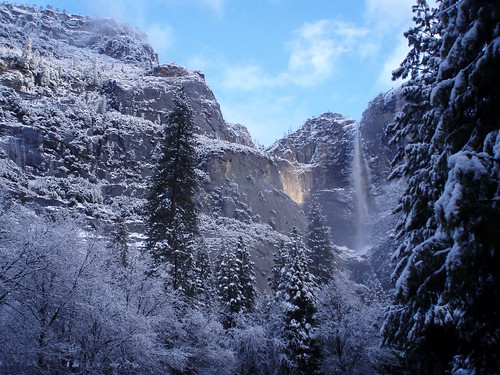 This year's Yosemite in January family trip took place in March. Edward Abbey has explained the need for the weekend better than I could.
This year's Yosemite in January family trip took place in March. Edward Abbey has explained the need for the weekend better than I could....do not burn yourselves out. Be as I am — a reluctant enthusiast...a part-time crusader, a half-hearted fanatic.
We drove up Friday during a midnight snowstorm. Saturday morning's first light: one patch of gold shining on a glittering silver wall.
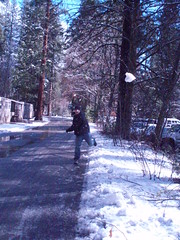
Save the other half of yourselves and your lives for pleasure and adventure. It is not enough to fight for the land; it is even more important to enjoy it. While you can. While it’s still here.

Of course, the best way to enjoy snow-covered land is to throw snowballs at an innocent, defenseless, camera-wielding parent.
I've been slimed!

So get out there and hunt and fish and mess around with your friends, ramble out yonder and explore the forests, climb the mountains, bag the peaks, run the rivers, breathe deep of that yet sweet and lucid air, sit quietly for a while and contemplate the precious stillness, the lovely, mysterious, and awesome space.Yosemite in winter has one-tenth of its summer human population but its full complement of animals. The snow may bring a sense of stillness, but Yosemite is never silent. My meadow running path took me between two scarlet winged blackbirds having a trill-off. A coyote trotted along the riverbank, ducks swam in a vernal pond, and deer grazed by the visitors' center.
We skiied cross-country to a glimpse of Glacier Point and a world painted in only three colors: pure white, evergreen, and that dazzling blue of a clear sky. No can of paint will ever be able to match the most perfect shade of blue in the known universe.
 Each below-freezing night, Yosemite Falls becomes outlined with an ice rim from frozen spray, and each warm day the ice falls off in huge chunks, rumbling and crashing down the cliff. The entire Valley echoes with the sound of a localized, constant thunderstorm in a cloudless azure sky.
Each below-freezing night, Yosemite Falls becomes outlined with an ice rim from frozen spray, and each warm day the ice falls off in huge chunks, rumbling and crashing down the cliff. The entire Valley echoes with the sound of a localized, constant thunderstorm in a cloudless azure sky. In the flatlands below the Sierra, lupines cast a cobalt haze on green meadows, but winter still blankets the high country. Yosemite Valley shares the best aspects of both: snow falls but doesn't linger too long. By Sunday evening, almost all of Friday night's snow had melted, and what was left was hard and icy.
As a California native who thinks snow should be visited once a year, I lack snow skills. In particular, I don't know how to build a snowman. My teen said, "But Calvin and Hobbes make it look so easy!" After much packing, we managed to turn one found snowball into a proper three-ball snowman.
Enjoy yourselves, keep your brain in your head and your head firmly attached to the body, the body active and alive, and I promise you this much; I promise you this one sweet victory over our enemies, over those desk-bound men and women with their hearts in a safe deposit box, and their eyes hypnotized by desk calculators. I promise you this: You will outlive the bastards.
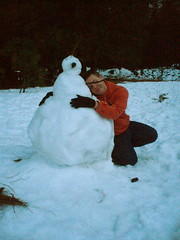
My son is fascinated by Russia and political theory, so he named the snowman Wasp Dimitrius Lenin Marx Rasputin. I felt that global warming was bothering the snowman, so I lent him a jacket and renamed him Senator Inhofe. He'll be gone within a few weeks. I can only hope that the wrongs the Senator from Oklahoma commits against the planet will likewise melt away when exposed to sunlight.
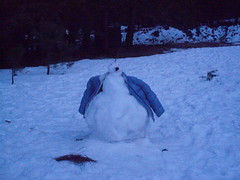 On the way back home, I was hit with a stark reminder of the half-hearted fanatic's other half. A sign in the foothills bragged: "Pombo, Conservative for Congress." Yes, Richard Pombo, the extreme private property rights, enemy of the earth, ethically challenged former member of Congress who sought to sell off our national treasures and gut the Endangered Species Act, having been voted out of the 11th Congressional district, is now running in the 19th, which includes Yosemite. Retiring George Radanovich was bad for Yosemite, but Pombo will be a horror. Thus, I both enjoy the land and fight for it; each is necessary but not sufficient.
On the way back home, I was hit with a stark reminder of the half-hearted fanatic's other half. A sign in the foothills bragged: "Pombo, Conservative for Congress." Yes, Richard Pombo, the extreme private property rights, enemy of the earth, ethically challenged former member of Congress who sought to sell off our national treasures and gut the Endangered Species Act, having been voted out of the 11th Congressional district, is now running in the 19th, which includes Yosemite. Retiring George Radanovich was bad for Yosemite, but Pombo will be a horror. Thus, I both enjoy the land and fight for it; each is necessary but not sufficient.
Friday, March 19, 2010
Random thoughts on Highway 99
I've driven the LA-to-Fresno more times than I can count beginning in the early 1980s. The billboards used to be what you'd expect in an agricultural, conservative community. "Food grows where water flows." "The weeder with the wiggle." "Abortion stops a beating heart." Ads for the Perko's diner, with lots of coffee pots.
In the early 2000s, new billboards sprouted like the housing tracts they advertised. "Own your home for $99,000." Then "Your dream home for $199,000." Later, "Starting at $299,000" and even "The American Dream, $399,000."
They're all gone, those housing tract ads. They've been replaced with...government ads. "Read.gov." "Census.gov" (that one showed up a lot). An adorable Hispanic toddler girl is another reason why you need food stamps.
But the politics haven't changed. The voters still hate government.
In the early 2000s, new billboards sprouted like the housing tracts they advertised. "Own your home for $99,000." Then "Your dream home for $199,000." Later, "Starting at $299,000" and even "The American Dream, $399,000."
They're all gone, those housing tract ads. They've been replaced with...government ads. "Read.gov." "Census.gov" (that one showed up a lot). An adorable Hispanic toddler girl is another reason why you need food stamps.
But the politics haven't changed. The voters still hate government.
Thursday, March 11, 2010
Hike On! Tarring Obama for a federal land grab that wasn't
Skepticism might be warranted for a Fox News exclusive, especially when it's accompanied by a Republican threatening tar and pitchforks over a non-event. A few weeks ago the vulpine network hyperventilated when it obtained a leaked memo: Obama Eyes Western Land for National Monuments, Angering Some, claiming that
Welcome to the Republican outrage machine, working hand in paw with Fox to hurt Western state Democrats.
Every viewer of Ken Burns' documentary knows that the Antiquities Act of 1906 might have originally been written to protect Anazasi ruins from pot hunters, but thanks to language permitting a President to declare objects of "scientific interest," was almost immediately was used by President Theodore Roosevelt chafing at Congressional dawdling to declare large swaths of land off limits to development. Arches (UT), Grand Canyon (AZ), Grand Teton (WY), and Katmai (AK), among others, all began as national monuments before becoming national parks. However, there's more to this tale than just inflammatory and misleading writing.
 Fox's ire centers on a Department of the Interior memo, headed "internal draft -- not for release," obtained by Rob Bishop (R-UT) and now available on a House Republican website (pdf).
Fox's ire centers on a Department of the Interior memo, headed "internal draft -- not for release," obtained by Rob Bishop (R-UT) and now available on a House Republican website (pdf).
The memo lists 13 areas in the West, beginning with the San Rafael Swell in Utah, worthy of further evaluation:
Bishop, the national parks' worst enemy in Congress, obtained the memo from a -mole- trusted source and ran to Fox, yelling:
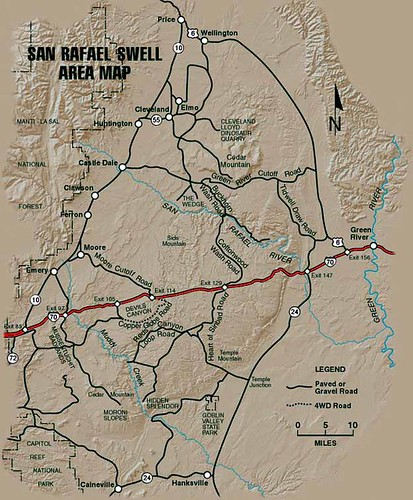 The Fox story goes on to compare Obama's "land grab" to Clinton's Grand Staircase-Escalante National Monument, which infuriated residents, at least until they began to see opportunities for tourism.
The Fox story goes on to compare Obama's "land grab" to Clinton's Grand Staircase-Escalante National Monument, which infuriated residents, at least until they began to see opportunities for tourism.
And the Fox story underlines perceived political peril for President Obama, courtesy of a Bush-era source:
So how far along is the secret land grab?
Not happening at all, says absolutely everyone not named Bishop. Utah's governor Gary Herbert met with Ken Salazar to be assured that nothing is being fast-tracked in clandestine meetings. The New York Times reports that the memo was simply a brainstorming session, not a secret at all. Even the Fox story is honest enough, at its very end, to check with an Interior Department spokesperson, who says (contrary to Bishop): the memo "reflects some brainstorming discussions within [the Bureau of Land Management], but no decisions have been made about which areas, if any, might merit more serious review and consideration." Just to score cheap political points, Senators Bennett (R-UT) and Hatch (R-UT) and Representative Bishop have introduced a bill requiring Congressional consent before any national monuments are declared in Utah.
All that outrage, all that tar stirred, all those pitchforks collected, for a chimera! Leaving several interesting if self-evident questions:
Presidential use of the Antiquities Act is highly controversial because the White House, with the stroke of a pen, can lock up thousands of square miles of federal lands used for timber, ranching, mining and energy development without local input or congressional approval. The Act is generally interpreted to commemorate or protect a specific historical landmark, not prohibit development or deprive local communities of jobs and tax revenues.
Welcome to the Republican outrage machine, working hand in paw with Fox to hurt Western state Democrats.
Every viewer of Ken Burns' documentary knows that the Antiquities Act of 1906 might have originally been written to protect Anazasi ruins from pot hunters, but thanks to language permitting a President to declare objects of "scientific interest," was almost immediately was used by President Theodore Roosevelt chafing at Congressional dawdling to declare large swaths of land off limits to development. Arches (UT), Grand Canyon (AZ), Grand Teton (WY), and Katmai (AK), among others, all began as national monuments before becoming national parks. However, there's more to this tale than just inflammatory and misleading writing.
 Fox's ire centers on a Department of the Interior memo, headed "internal draft -- not for release," obtained by Rob Bishop (R-UT) and now available on a House Republican website (pdf).
Fox's ire centers on a Department of the Interior memo, headed "internal draft -- not for release," obtained by Rob Bishop (R-UT) and now available on a House Republican website (pdf). The memo lists 13 areas in the West, beginning with the San Rafael Swell in Utah, worthy of further evaluation:
Located in South-Central Utah, the San Rafael Swell is a 75 by 40 mile giant dome made of sandstone, shale and limestone -- one of the most spectacular displays of geology in the country. The Swell is surrounded by canyons, gorges, mesas and buttes and is home to eight rare plant species, desert big horns, coyotes, bobcats, cottontail rabbits, badgers, gray and kit fox, and the golden eagle. Visitors to the area can find ancient Indian rock art and explore a landscape with geographic features resembling those found on Mars.The Bureau of Land Management already manages much of the San Rafael Swell, in which geology has folded, twisted, and contorted the land. Miles of waterless slot canyons can be reached only by four wheel drive or very prepared hikers. No humans live in such inhospitable terrain. For the practical among us, the San Rafael Swell is bisected by I-70 between its western terminus at Salina and Green River, nearly 100 miles of seductive, steep, sinuous curves, no radio reception, and no motorist services. (Map, below, credit: San Rafael Swell) The Mars Society, an organization devoted to exploring the Red Planet, selected the Swell to best simulate Mars in setting up a Mars Desert Research Station. Former Utah governor Mike Leavitt, a Republican, advocated a San Rafael National Monument in 2002, echoing a similar push in the 1930s. The Swell is also part of a proposed America's Red Rock Wilderness Act.
Bishop, the national parks' worst enemy in Congress, obtained the memo from a -mole- trusted source and ran to Fox, yelling:
We are taking this seriously. The tar is warming up. The pitchforks are ready.
 The Fox story goes on to compare Obama's "land grab" to Clinton's Grand Staircase-Escalante National Monument, which infuriated residents, at least until they began to see opportunities for tourism.
The Fox story goes on to compare Obama's "land grab" to Clinton's Grand Staircase-Escalante National Monument, which infuriated residents, at least until they began to see opportunities for tourism. And the Fox story underlines perceived political peril for President Obama, courtesy of a Bush-era source:
The list contains a number of political land mines for the president, according to a former Bush Interior Department appointee familiar with the document who asked to remain anonymous.
"Right now a number of senior officials are going over the report," he told Fox News. "When Clinton did it, most of the West was red states and he didn't have any blowback. Obama has to ask himself, if he chooses a Nevada location, will it hurt (Senator Harry) Reid's re-election. The same is true in almost every (Western) state where Democrats have made serious inroads."
So how far along is the secret land grab?
Not happening at all, says absolutely everyone not named Bishop. Utah's governor Gary Herbert met with Ken Salazar to be assured that nothing is being fast-tracked in clandestine meetings. The New York Times reports that the memo was simply a brainstorming session, not a secret at all. Even the Fox story is honest enough, at its very end, to check with an Interior Department spokesperson, who says (contrary to Bishop): the memo "reflects some brainstorming discussions within [the Bureau of Land Management], but no decisions have been made about which areas, if any, might merit more serious review and consideration." Just to score cheap political points, Senators Bennett (R-UT) and Hatch (R-UT) and Representative Bishop have introduced a bill requiring Congressional consent before any national monuments are declared in Utah.
All that outrage, all that tar stirred, all those pitchforks collected, for a chimera! Leaving several interesting if self-evident questions:
How are preliminary brainstorming session memos being leaked to Republicans in Congress known to hate national lands?
Why is Fox aiding Bishop in inflating a brainstorming memo into a secret land grab?
Has this draft internal memo been blown up into an "exclusive" for any purpose other than the purpose of undermining support for Democrats in Western states?
Am I the only one bothered by the threat by a member of Congress to tar and pitchfork a President?
And why on earth shouldn't the San Rafael Swell be a national monument anyway?
Slouching Toward Copenhagen
A post that I wrote shortly before the Copenhagen climate conference. My pessimism was, I believe, largely borne out by events.

the spin machine twirls and curls: Email fracas shows perils of trying to spin science
Yeats predicts: "The end of an age, which always receives the revelation of the character of the next age, is represented by the coming of one gyre to its place of greatest expansion and of the other to its place of greatest contraction... The revelation [that] approaches will... take its character from the contrary movement of the interior gyre...." Meanwhile, the spinners succeed and the mainstream media are misdirected in the stolen email story.

and people cease listening to inconvenient truths of science and reason as fewer Americans continue to believe in global warming; the Australian opposition party dumps its leader over climate legislation; and a new survey shows that world concerns about global warming have dwindled.
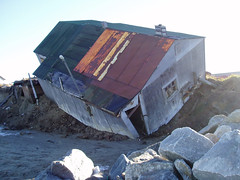
Senate chairs split over climate bill; "Hanging in the balance is one of President Barack Obama’s top domestic priorities, as well as the president’s credibility among potential signatories to an international climate pact." Meanwhile, UN environmental chief calls upon United States and China to raise their offers.

A survey delving into the past 30 years in sub-Saharan Africa reveals that temperature changes match up with a significant increase in the likelihood of civil war. Both the 1994 Rwandan civil war and the 2000s Darfur conflict are generally seen to be wars for scarce resources. The Pentagon begins to war game the implications of climate change including famine, rising sea levels, and natural resource competition.
When it comes to the stability of one of the world's most volatile regions, it's the fate of the Himalayan glaciers that should be keeping us awake at night. Although India and Pakistan have entered into a treaty regarding use of waters flowing from Himalayan glaciers, the treaty's success depends on the maintenance of a status quo that will be disrupted as the world warms. The Himalayan glaciers supply water to a billion people in India, Pakistan, and western China; a billion people with nuclear weapons; a billion people with nuclear weapons who do not have a history of getting along. Scientists originally predicted that they would largely melt by 2035, but their melt has accelerated.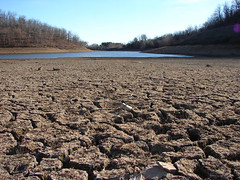 Meanwhile, California's water woes are just the beginning for the United States as water becomes the new oil.
Meanwhile, California's water woes are just the beginning for the United States as water becomes the new oil.
Climate science is not and never will be settled, the RealClimate editors say, while acknowledging that naysayers such as Wall Street Journal editors will seize upon smidgens of uncertainty. Senator Jeff Bingaman (D-NM) wants to consider other options besides the cap and trade bill approved by the House, and leftists attempt to resurrect the idea of a carbon tax.
Hacked Emails give Inhofe fuel for climate change debate. Four Republicans (Representatives Sensenbrenner and Issa and Senators Barasso and Vitter) have demanded that the Environmental Protection Agency cease all work on greenhouse gases. Sarah Palin uses Facebook to demand that President Obama investigate the "snake oil science" of climate instead of going to Copenhagen. Representatives Joe Barton and Greg Walden call for hearings on NASA scientists.
The Pope tells Copenhagen participants to respect God's creation and promote development while respecting human dignity and the common good.

Copenhagen's green credentials obscure unpleasant facts, such as Denmark's continued reliance on coal-fired plants, Danish society's highly consumerist society, and its beef habit (in 2002, the average Dane consumed a whopping 321 pounds of meat -- nearly a pound a day. For Americans, the figure was 275 pounds).
 Australia faces collapse caused by desertification. Wildfires in February 2009 (late summer) killed hundreds, and November 2009 (spring) broke so many records "that for a lot of places, even average conditions for the rest of the month will be easily enough to break existing records," says a climatologist. A new dust bowl has emerged in California's Fresno County.
Australia faces collapse caused by desertification. Wildfires in February 2009 (late summer) killed hundreds, and November 2009 (spring) broke so many records "that for a lot of places, even average conditions for the rest of the month will be easily enough to break existing records," says a climatologist. A new dust bowl has emerged in California's Fresno County.
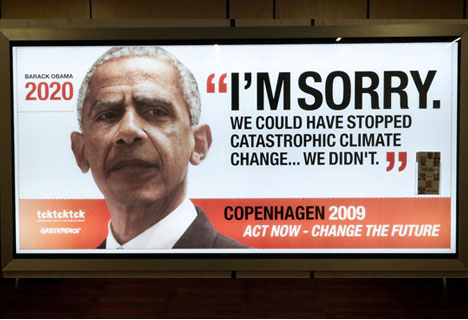 Climate drama climax looks elusive: "Too little time and too little agreement, however, especially between rich and poor countries, mean the 192-nation Copenhagen conference is likely to produce, at best, a framework — a basis for continuing talks and signing internationally binding final agreements next year." Carbon pledges made to date will stoke potentially catastrophic 3.5 degrees Celsius warming by century's end, warns the Potsdam Institute for Climate Impact Research in Germany and energy specialists Ecofys. The pledges on the table will not halt emissions growth before 2040, let alone by 2015 as indicated by the IPCC. Negotiators at Copenhagen face deep sets of fault lines, including rich vs poor nations, developed vs developing countries, Poland and Estonia vs the rest of the EU, island nations vs time, OPEC vs clean technology, and urgency vs inertia.
Climate drama climax looks elusive: "Too little time and too little agreement, however, especially between rich and poor countries, mean the 192-nation Copenhagen conference is likely to produce, at best, a framework — a basis for continuing talks and signing internationally binding final agreements next year." Carbon pledges made to date will stoke potentially catastrophic 3.5 degrees Celsius warming by century's end, warns the Potsdam Institute for Climate Impact Research in Germany and energy specialists Ecofys. The pledges on the table will not halt emissions growth before 2040, let alone by 2015 as indicated by the IPCC. Negotiators at Copenhagen face deep sets of fault lines, including rich vs poor nations, developed vs developing countries, Poland and Estonia vs the rest of the EU, island nations vs time, OPEC vs clean technology, and urgency vs inertia.

The earth is the hottest it's been in 2,000 years, the National Academy of Sciences reported in 2006. More recently, a paper authored by Northern Arizona University professors found the warmest temperatures in 2,000 years at a time when the Arctic would be cooling if not for greenhouse gas emissions overpowering natural climate patterns.

Is a revelation at hand for an inherently cautious group? Will bickering nations unite against a common enemy? Or will things fall apart as the Earth cannot hold its people?

Turning and turning in the widening gyre
the spin machine twirls and curls: Email fracas shows perils of trying to spin science
Yeats predicts: "The end of an age, which always receives the revelation of the character of the next age, is represented by the coming of one gyre to its place of greatest expansion and of the other to its place of greatest contraction... The revelation [that] approaches will... take its character from the contrary movement of the interior gyre...." Meanwhile, the spinners succeed and the mainstream media are misdirected in the stolen email story.

The falcon cannot hear the falconer;
and people cease listening to inconvenient truths of science and reason as fewer Americans continue to believe in global warming; the Australian opposition party dumps its leader over climate legislation; and a new survey shows that world concerns about global warming have dwindled.

Things fall apart; the centre cannot hold;
Senate chairs split over climate bill; "Hanging in the balance is one of President Barack Obama’s top domestic priorities, as well as the president’s credibility among potential signatories to an international climate pact." Meanwhile, UN environmental chief calls upon United States and China to raise their offers.
Mere anarchy is loosed upon the worldThe United States Senate puts off climate bill until spring because, according to Claire McCaskill (D-MO), the climate bill is "really big, really, really hard, and is going to make a lot of people mad." In India, climate loan sharks flourish as droughts and failed crops worsen the cycle of poverty. The country of Tuvalu is drowning and its people migrating to New Zealand.

The blood-dimmed tide is loosed, and everywhere
A survey delving into the past 30 years in sub-Saharan Africa reveals that temperature changes match up with a significant increase in the likelihood of civil war. Both the 1994 Rwandan civil war and the 2000s Darfur conflict are generally seen to be wars for scarce resources. The Pentagon begins to war game the implications of climate change including famine, rising sea levels, and natural resource competition.
The ceremony of innocence is drowned;
When it comes to the stability of one of the world's most volatile regions, it's the fate of the Himalayan glaciers that should be keeping us awake at night. Although India and Pakistan have entered into a treaty regarding use of waters flowing from Himalayan glaciers, the treaty's success depends on the maintenance of a status quo that will be disrupted as the world warms. The Himalayan glaciers supply water to a billion people in India, Pakistan, and western China; a billion people with nuclear weapons; a billion people with nuclear weapons who do not have a history of getting along. Scientists originally predicted that they would largely melt by 2035, but their melt has accelerated.
 Meanwhile, California's water woes are just the beginning for the United States as water becomes the new oil.
Meanwhile, California's water woes are just the beginning for the United States as water becomes the new oil. The best lack all conviction,
Climate science is not and never will be settled, the RealClimate editors say, while acknowledging that naysayers such as Wall Street Journal editors will seize upon smidgens of uncertainty. Senator Jeff Bingaman (D-NM) wants to consider other options besides the cap and trade bill approved by the House, and leftists attempt to resurrect the idea of a carbon tax.
while the worst
Are full of passionate intensity.
Hacked Emails give Inhofe fuel for climate change debate. Four Republicans (Representatives Sensenbrenner and Issa and Senators Barasso and Vitter) have demanded that the Environmental Protection Agency cease all work on greenhouse gases. Sarah Palin uses Facebook to demand that President Obama investigate the "snake oil science" of climate instead of going to Copenhagen. Representatives Joe Barton and Greg Walden call for hearings on NASA scientists.
Surely some revelation is at hand;
Surely the Second Coming is at hand.
The Pope tells Copenhagen participants to respect God's creation and promote development while respecting human dignity and the common good.

The Second Coming! Hardly are those words out
Copenhagen's green credentials obscure unpleasant facts, such as Denmark's continued reliance on coal-fired plants, Danish society's highly consumerist society, and its beef habit (in 2002, the average Dane consumed a whopping 321 pounds of meat -- nearly a pound a day. For Americans, the figure was 275 pounds).
When a vast image out of Spiritus Mundi
Troubles my sight: somewhere in sands of the desert
 Australia faces collapse caused by desertification. Wildfires in February 2009 (late summer) killed hundreds, and November 2009 (spring) broke so many records "that for a lot of places, even average conditions for the rest of the month will be easily enough to break existing records," says a climatologist. A new dust bowl has emerged in California's Fresno County.
Australia faces collapse caused by desertification. Wildfires in February 2009 (late summer) killed hundreds, and November 2009 (spring) broke so many records "that for a lot of places, even average conditions for the rest of the month will be easily enough to break existing records," says a climatologist. A new dust bowl has emerged in California's Fresno County.A shape with lion body and the head of a man,
A gaze blank and pitiless as the sun,
Is moving its slow thighs, while all about it
 Climate drama climax looks elusive: "Too little time and too little agreement, however, especially between rich and poor countries, mean the 192-nation Copenhagen conference is likely to produce, at best, a framework — a basis for continuing talks and signing internationally binding final agreements next year." Carbon pledges made to date will stoke potentially catastrophic 3.5 degrees Celsius warming by century's end, warns the Potsdam Institute for Climate Impact Research in Germany and energy specialists Ecofys. The pledges on the table will not halt emissions growth before 2040, let alone by 2015 as indicated by the IPCC. Negotiators at Copenhagen face deep sets of fault lines, including rich vs poor nations, developed vs developing countries, Poland and Estonia vs the rest of the EU, island nations vs time, OPEC vs clean technology, and urgency vs inertia.
Climate drama climax looks elusive: "Too little time and too little agreement, however, especially between rich and poor countries, mean the 192-nation Copenhagen conference is likely to produce, at best, a framework — a basis for continuing talks and signing internationally binding final agreements next year." Carbon pledges made to date will stoke potentially catastrophic 3.5 degrees Celsius warming by century's end, warns the Potsdam Institute for Climate Impact Research in Germany and energy specialists Ecofys. The pledges on the table will not halt emissions growth before 2040, let alone by 2015 as indicated by the IPCC. Negotiators at Copenhagen face deep sets of fault lines, including rich vs poor nations, developed vs developing countries, Poland and Estonia vs the rest of the EU, island nations vs time, OPEC vs clean technology, and urgency vs inertia.
Reel shadows of the indignant desert birds.

The darkness drops again; but now I know
That twenty centuries of stony sleep
Were vexed to nightmare by a rocking cradle
The earth is the hottest it's been in 2,000 years, the National Academy of Sciences reported in 2006. More recently, a paper authored by Northern Arizona University professors found the warmest temperatures in 2,000 years at a time when the Arctic would be cooling if not for greenhouse gas emissions overpowering natural climate patterns.

And what rough beast, its hour come round at last,
Slouches towards Bethlehem to be born?
Is a revelation at hand for an inherently cautious group? Will bickering nations unite against a common enemy? Or will things fall apart as the Earth cannot hold its people?
Labels:
climate change,
Copenhagen,
global warming,
W.B. Yeats
Wednesday, March 10, 2010
Hike On! On a clear day, can you see Four Corners?
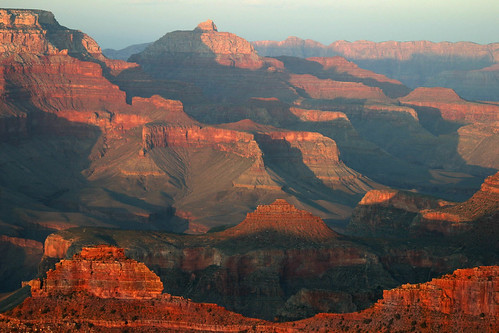 The great national parks of the Southwest overwhelm visitors with a sense of space. The air is limitless, dazzling, so crystalline clear it pierces the lungs and the soul. On the rim of the Grand Canyon, you imagine you can see forever -- an average of 106 miles, and up to 160 miles on clearest days. Bryce Canyon, with its aptly named Farview Point, offers panoramic views of three states, visibility up to 200 miles, and "dark skies" night astronomy programs in which visitors can see up to 7500 stars. Red sandstone of Delicate Arch, in Arches National Park, frames a perfect blue sky.
The great national parks of the Southwest overwhelm visitors with a sense of space. The air is limitless, dazzling, so crystalline clear it pierces the lungs and the soul. On the rim of the Grand Canyon, you imagine you can see forever -- an average of 106 miles, and up to 160 miles on clearest days. Bryce Canyon, with its aptly named Farview Point, offers panoramic views of three states, visibility up to 200 miles, and "dark skies" night astronomy programs in which visitors can see up to 7500 stars. Red sandstone of Delicate Arch, in Arches National Park, frames a perfect blue sky. Unless the haze obstructs the view.
One purpose of the Clean Air Act is "to preserve, protect, and enhance the air quality in national parks." Most national parks, wilderness areas, and certain national forests and national wildlife refuges are labeled Class I, giving the involved federal agency some obligation to prevent significant deterioration of air quality caused by outside sources within 300 kilometers.
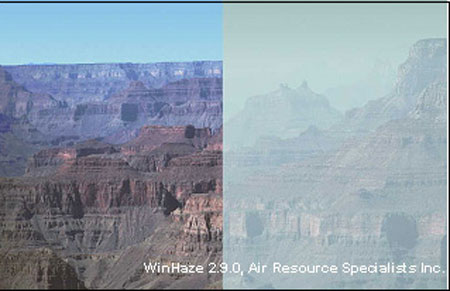 An entire federal program, Interagency Monitoring of Protected Visual Environments, or IMPROVE, is dedicated to monitoring and protecting air quality in the national parks and wilderness areas. Many parks have webcams, showing not only a view of the park but also air quality, such as the informative Grand Canyon webcam. (True confession -- I use the Yosemite webcam page as a mental health break.)
An entire federal program, Interagency Monitoring of Protected Visual Environments, or IMPROVE, is dedicated to monitoring and protecting air quality in the national parks and wilderness areas. Many parks have webcams, showing not only a view of the park but also air quality, such as the informative Grand Canyon webcam. (True confession -- I use the Yosemite webcam page as a mental health break.)The NPS' most recent 2008 report on air quality in parks shows that ozone levels at Great Basin (NV) and Mesa Verde (CO), both remote parks far from any large population center, are surprisingly high and are of particular concern.
The Bush administration proposed weakening the Class I rules by permitting coal plants and other haze-creators to be placed closer to national parks. The National Parks Conservation Association identified ten parks most threatened by coal plants in Dark Horizons (33 pg pdf), including Capitol Reef (UT), Great Basin, Mesa Verde, and Zion (UT) National Parks. Ultimately the Bush administration backed down.
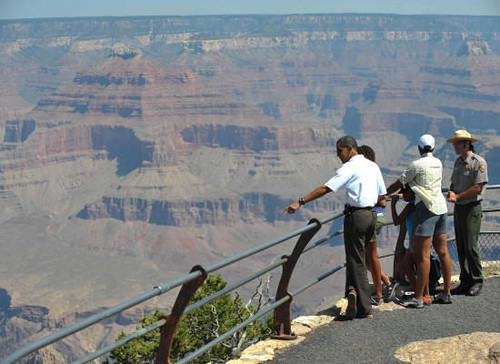 Two notorious sources of haze in the Southwest are the Four Corners and Black Mesa coal plants.
Two notorious sources of haze in the Southwest are the Four Corners and Black Mesa coal plants. The Four Corners plant, located west of Farmington, NM burns 10 million tons of coal every year. It's the largest single source of air pollution in the state of New Mexico, according to the Arizona Public Service's monitoring reports. And the NPS has found that Four Corners has the greatest visibility impact on Class I national parks of any coal plant in the country. The coal plant particularly threatens clean, clear air at Arches, Canyonlands, and Mesa Verde national parks. Last month, a coalition of environmental groups petitioned the DOI and USDA to declare that the Four Corners plant is violating the Clean Air Act by polluting the air at sixteen Class I national parks.
The Black Mesa power plant complex, no stranger to controversy, was set up with apparent sweetheart deals on Hopi and Navajo land in the 1960s. The complex consists of two separate strip mining operations: Black Mesa and Kayenta. Black Mesa was shut down in 2005 rather than comply with environmental regulations, while Kayenta kept going. As part of the Bush administration midnight anti-environmental regulations in December 2008, a permit to combine the two (effectively reopening Black Mesa) for the life of the mine was approved. However, in January 2010, an administrative law judge rescinded the permit, sending the reopening of Black Mesa back to the drawing board for a new environmental impact statement. Chalk this victory up for the good guys. (Note: the Black Mesa story has layers of tragedy, exploitation, and environmental injustice going far beyond haze over the Grand Canyon. Black Mesa Indigenous Support and similar websites have more information than can be covered in this diary.)
The casual national park visitor's view over the Grand Canyon is certainly not the only reason to shut down places like Four Corners and Black Mesa. However, it's another harm instigated by the burning of fossil fuels, another reason to convince your nonpolitical friends that we need to move to clean energy, and another reason why carbon pollution should not continue unchecked.
Labels:
Arches,
Black Mesa,
Bryce Canyon,
Clean Air Act,
coal,
environment,
Four Corners,
Grand Canyon,
Hike On,
Mesa Verde,
national parks
Tuesday, March 9, 2010
Welcome
Speaking for our lands, public and otherwise, the creatures that live on them, and the politics of same. Also, chickens.
Subscribe to:
Posts (Atom)